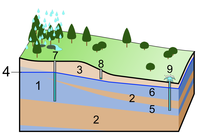
Photo from wikipedia
The large volume and high salinity of produced water (PW) could pose severe environmental impacts. This paper presents the laboratory results on PW from G oil field, located in North… Click to show full abstract
The large volume and high salinity of produced water (PW) could pose severe environmental impacts. This paper presents the laboratory results on PW from G oil field, located in North Africa, and on groundwater samples from nearby freshwater wells, in order to best comprehend the chemical composition of PW and to evaluate their potential impact on the surrounding environment of this oil field. Such a sizeable data set can make it difficult to integrate, interpret and represent the results. Thus, multivariate statistical techniques were used in the usefulness evaluation of geochemical groundwater control process classification and identification. Principal component analysis of produced water identified three components: the first being a salinization factor that accounted for 53.6% of the overall variance; the second accounted for 24.3% of overall variance and was mostly dictated by scale forming potential; and the third component (12.3% of total variance) representing the quality of the water formed by the rock water interaction. The aforementioned components demonstrated that the quality of discharged produced water didn’t meet national or international standards. For the groundwater analysis, two principal components/clusters were identified. The first one (69.6% of total variance) represented the hardness and salinity of the water, and the second one (18.4% of total variance) can be regarded as the overall effect of weathering and interactions between water and rock on the groundwater quality factor in general. The analysis did not show any contamination in groundwater at the G oil field and in the nearby farms water wells.
Journal Title: International Journal of Environmental Science and Technology
Year Published: 2019
Link to full text (if available)
Share on Social Media: Sign Up to like & get
recommendations!